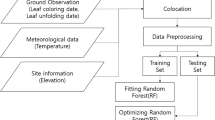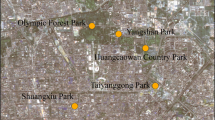Abstract
We evaluated the spatial characteristics of the first day of peak leaf colouring (PLCstart) and their relationships with air temperature along latitudinal and elevational gradients in Japan from 2015 to 2017. Leaf colouring information collected from more than 740 sites via citizen science was analysed, representing elevations from 0 to 2800 m and latitudes from 32°N to 44°N. We found that locations with earlier PLCstart dates (day of year 265–294) displayed steeper slopes in elevation per degree of latitude than locations with later PLCstart dates (day of year 295–314). This statistically significant result indicates that the influence of elevation on PLCstart (vertical gradient) weakened as the leaf colouring season progressed in Japan. In addition to these spatial characteristics, the PLCstart and the warmth index (based on monthly mean air temperature) showed significant linear correlations for latitudinal and elevational gradients. This result suggests that the sensitivity of PLCstart to air temperature, as manifested in both latitudinal and elevational gradients, is constant. This study suggests that online phenological data may provide more accurate results for a regional scale (100–1000 km) than the datasets used by previous studies.




Similar content being viewed by others
References
Archetti M, Richardson AD, O’Keefe J, Delpierre N (2013) Predicting climate change impacts on the amount and duration of autumn colors in a New England forest. PLoS One 8(3):e57373. https://doi.org/10.1371/journal.pone.0057373
Chen XQ, Xu L (2012) Phenological responses of Ulmus pumila (Siberian elm) to climate change in the temperate zone of China. Int J Biometeorol 56:695–706
Delpierre N, Dufrêne E, Soudani K, Ulrich E, Cecchini S, Boé J, François C (2009) Modelling interannual and spatial variability of leaf senescence for three deciduous tree species in France. Agric For Meteorol 149:938–948
Doi H, Takahashi M (2008) Latitudinal patterns in the phenological responses of leaf colouring and leaf fall to climate change in Japan. Glob Ecol Biogeogr 17:556–561. https://doi.org/10.1111/j.1466-8238.2008.00398.x
Gallinat AS, Primack RB, Wagner DL (2015) Autumn, the neglected season in climate change research. Trends in Ecol Evo 30(3):169–176
Gill AL, Gallinat AS, Sanders-DeMott R, Rigden AJ, Gianotti DJS, Mantooth JA, Templer PH (2015) Changes in autumn senescence in northern hemisphere deciduous trees: a meta-analysis of autumn phenology studies. Annals of Botany. https://doi.org/10.1093/aob/mcv055
Hayashi I (1990) Vegetation geography. Taimeido, Tokyo, p 269 (In Japanese)
Inoue T, Nagai S, Saitoh TM, Muraoka H, Nasahara KN, Koizumi H (2014) Detection of the different characteristics of year-to-year variation in foliage phenology among deciduous broad-leaved tree species by using daily continuous canopy surface images. Ecol Inform 22:58–68
Japan Meteorological Agency (JMA) (2019) Observed meteorological data by the automated meteorological data acquisition system (AMeDAS). Available online: https://www.data.jma.go.jp/gmd/risk/obsdl/index.php. (accessed 17 March 2020)
Kira T. (1945) A new classification of climate in eastern Asia as the basis for agricultural geography, Horticultural Institute, Kyoto Univ., Kyoto 23 pp. (In Japanese)
Kira T (1991) Forest ecosystems of east and Southeast Asia in a global perspective. Ecol Res 6:185–200
Klosterman S, Richardson AD (2017) Observing spring and fall phenology in a deciduous forest with aerial drone imagery. Sensors 17(2852). https://doi.org/10.3390/s17122852
Klosterman S, Melaas E, Wang JA, Martinez A, Frederick S, O’Keefe J, Orwig DA, Wang Z, Sun Q, Schaaf C, Friedl M, Richardson AD (2018) Fine-scale perspectives on landscape phenology from unmanned aerial vehicle (UAV) photography. Agric For Meteorol 248:397–407
Lim PO, Kim HJ, Nam HG (2007) Leaf senescence. Annu Rev Plant Physiol 58:115–136
Liu Z, An S, Lu X, Hu H, Tang J (2018) Using canopy greenness index to identify leaf ecophysiological traits during the foliar senescence in an oak forest. Ecosphere 9(7):e02337
Nagai S, Saitoh TM, Nasahara KN, Suzuki R (2015a) Spatio-temporal distribution of the timing of start and end of growing season along vertical and horizontal gradients in Japan. Int J Biometeorol 59:47–54
Nagai S, Inoue T, Suzuki R (2015b) Leaf-coloring information published on web sites and its utility in the ground-truthing of satellite remote-sensing data for mapping autumn leaf phenology. Jpn J Biometeorol 52(2):119–129 (in Japanese with English abstract)
Nagai S, Nasahara K, Akitsu TK, Saitoh TM, Muraoka H (2020) Importance of the collection of abundant ground-truth data for accurate detection of spatial and temporal variability of vegetation by satellite remote sensing. In: Dontsova K, Balogh-Brunstad Z, Le Roux G (eds) Biogeochemical cycles. ecological drivers and environmental impact, Wiley, 336pp
NASA JPL (2013) NASA Shuttle Radar Topography Mission Global 1 arc second [data set]. NASA EOSDIS Land Processes DAAC. https://doi.org/10.5067/MEaSUREs/SRTM/SRTMGL1.003
Park C-K, Ho C-H, Jeong S-J, Lee EJ, Kim J (2017) Spatial and temporal changes in leaf coloring date of Acer palmatum and Ginkgo biloba in response to temperature increases in South Korea. PLoS One 12(3):e0174390. https://doi.org/10.1371/journal.pone.0174390
R Project for Statistical Computing (2015) https://www.r-project.org ()
Richardson AD, Bailey AS, Denny EG, Martin CW, O'Keefe J (2006) Phenology of a northern hardwood forest canopy. Glob Chang Biol 12:1174–1188
Richardson AD, Hufkens K, Li X, Ault TR (2019) Testing Hopkins’ bioclimatic law with PhenoCam data. Applications in Plant Sciences 7(3):e1228. https://doi.org/10.1002/aps3.1228
Rozenstein O, Adamowski J (2017) Linking spaceborne and ground observations of autumn foliage senescence in southern Québec, Canada. Remote Sens 9:630. https://doi.org/10.3390/rs9060630
Schwartz MD (ed) (2003) Phenology: an integrative environmental science. Kluwer Academic Publishers, Dordrecht
Suzuki K (2018) Importance of hydro-meteorological observation in the mountainous area. Jpn J Mountain Res 1:1–11 (in Japanese with English abstract)
Tadaki Y, Kitamura H, Kanie K, Sano H, Shigematsu A, Ohtsu S (1994) Leaf opening and falling of Japanese larch at different altitudes. Jpn J Ecol 44:305–314 (in Japanese with English abstract)
Xie Y, Wang X, Wilson AM, Silander JA Jr (2018) Predicting autumn phenology: how deciduous tree species respond to weather stressors. Agric For Meteorol 250–251:127–137
Yu R, Schwartz MD, Donnelly A, Liang L (2016) An observation-based progression modeling approach to spring and autumn deciduous tree phenology. Int J Biometeorol 60:335–349
Acknowledgements
We thank the editor and two anonymous reviewers for their kind and constructive comments. This study was supported by the Environment Research and Technology Development Fund (S-9) of the Ministry of the Environment of Japan and a KAKENHI grant (19H03301) of the Japan Society for the Promotion of Science.
Author information
Authors and Affiliations
Corresponding author
Additional information
Re-submitted to International Journal of Biometeorology
Rights and permissions
About this article
Cite this article
Nagai, S., Saitoh, T.M. & Miura, T. Peak autumn leaf colouring along latitudinal and elevational gradients in Japan evaluated with online phenological data. Int J Biometeorol 64, 1743–1754 (2020). https://doi.org/10.1007/s00484-020-01953-6
Received:
Revised:
Accepted:
Published:
Issue Date:
DOI: https://doi.org/10.1007/s00484-020-01953-6




